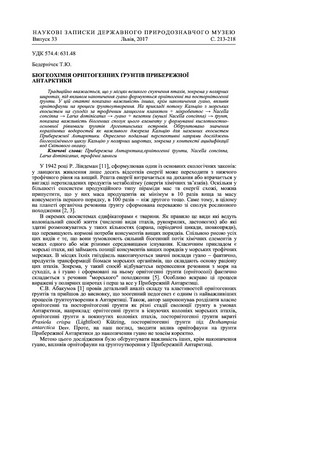Bedernichek T. Biogeochemistry of ornithogenic soils in Coastal Antarctica // Proc. of the State Nat. Hist. Mus. - Lviv, 2017. - 33. - P. 213-218.
DOI: https://doi.org/10.36885/nzdpm.2017.33.213-218
Key words: Coastal Antarctica, ornithogenic soils, Nacella concinna, Larus dominicanus, food
chain
Ornithogenic soils are usually considered to be formed as a result of breeding activities by sea birds. These soils are widespread in polar regions and in Coastal Antarctica in particular. It is believed that the most important impact of birds on soil formation in such environments is accumulation of guano – an important source of chemical elements and energy. In this paper we discuss an alternative point of view. We hypothesized that not only and not so much accumulation of guano, but also other bird-formed products significantly affect soil formation in Coastal Antarctica. An intensive biogenic flux of calcium from marine to terrestrial ecosystems in the food-chain: plankton + microbenthos → Nacella concinna → Larus dominicanus → guano + pellets (Nacella concinna shells) → soil strongly influences soil formation in Argentina islands by significant increase of soil pH values. The role of coral algae as an important source of calcium for terrestrial ecosystems of the Coastal Antarctic was shown. Further promising research priorities in the field of calcium biogeochemistry in polar environments were described.
References
- Abakumov E.V. Zoogennyi pedogenez kak osnovnoi biogennyi pochvennyi protcess v Antarktide // Rus. ornit. zhurn. – 2014. – № 23 (972). – S. 576-584. [In Russian]
- Bedernichek T.Yu., Hamkalo Z.H. Labilna orhanichna rechovyna gruntu: teoriia, metodolohiia, indykatorna rol. – K.: Kondor, 2014. – 180 s. [In Ukrainian]
- Zavarzin G.A. Lektcii po prirodovedcheskoi mikrobiologii. – M.: Nauka, 2004. – 348 s. [In Russian]
- Zaimenko N.V., Bedernichek T. Iu., Khoetckii P.B. Allelopaticheskaia aktivnost lugovika antarkticheskogo (Deschampsia antarctica Desv.) v kontekste globalnykh izmenenii klimata / Biull. Botan. sada-instituta. – 2016. – № 15. – S. 26-28. [In Russian]
- Zaimenko N.V., Bedernichek T.Iu., Shvartau V.V., Mikhalskaia L.N., Khoetckii P.B. Initcialnoe pochvoobrazovanie v Pribrezhnoi Antarktike: sushchestvuiut li ne ornitogennye pochvy? // Ukr. antarkt. zhurn. – 2016. – № 15. – S. 170-175. [In Russian]
- Parnikoza I.Iu., Abakumov E.V., Dikii I.V. i dr. Ornitogennye lokalitety Deschampsia antarctica v raione Argentinskikh ostrovov (Pribrezhnaia Antarktika) / Rus. ornit. zhurn. – 2014. – T. 23, Ekspress-vypusk № 1056. – S. 3095-3107. [In Russian]
- Parnikoza I.Iu., Abakumov E.V., Dikii I.V. i dr. Vliianie ptitc na prostranstvennoe raspredelenie Deschampsia antarctica Desv. ostrova Galindez (Argentinskie ostrova, Pribrezhnaia Antarktika) // Vest. Sankt-Peterburgskogo un-ta. Ser. 3: biologiia. – 2015. – № 1. – S. 78-97. [In Russian]
- Peklo A.M. Ptitcy Argentinskikh ostrovov i ostrova Piterman. – Krivoi Rog: Mineral, 2007. – 264 s. [In Russian]
- Favero M., Silva P., Ferreyra G. Trophic relationships between the kelp gull and the Antarctic limpet at King George Island (South Shetland Islands, Antarctica) during the breeding season / Polar Biology. – 1997. – № 17. – P. 431 -436.
- Higgins P.J., Davies S.J.J.F. Handbook of Australian, New Zealand and Antarctic Birds. Volume 3: Snipe to Pigeons. – Melbourne: Oxford University Press, 1996. – 1028 p.
- Lindeman R.L. The trophic-dynamic aspect of ecology // Ecology. – 1942. – № 23. – Р. 399-418.


